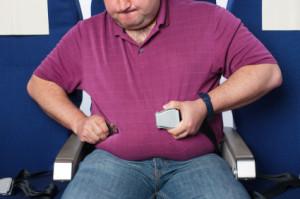 American waistlines continue to expand – about one in six adults in the U.S. is obese. While obesity poses many short and long-term health risks, it also has an impact on individuals’ ability to travel by plane. In fact, obese travelers and airline companies seem to be at odds.
American waistlines continue to expand – about one in six adults in the U.S. is obese. While obesity poses many short and long-term health risks, it also has an impact on individuals’ ability to travel by plane. In fact, obese travelers and airline companies seem to be at odds.
Quite simply, the travel industry hasn’t kept pace with growing waistlines. Between airline policies that favor the comfort of thinner travelers to the size of the seats on planes, air travel isn’t always comfortable or financially possible for heavier individuals. With industry-wide pressure to sell seats while maintaining customer safety and comfort, airlines enforce rules for passengers who are finding it difficult to fit into the standard 17-inch seats.
The U.S. Federal Aviation Administration (FAA) requires that airline passengers be able to sit with the seatbelt around their waist with both arm rests down to fulfill safety regulations. Seatbelts on planes have extensions to expand them, but if passengers can’t close their seatbelt, the FAA mandates that they can’t fly.
If you’re thinking about bringing your own seatbelt extender, think again – the FAA bans passengers from using personal seatbelt extenders on commercial flights because they’re not comprehensively tested for safety; extenders provided by airlines endure rigorous safety testing. Despite all being considered safe, the length of the extender and the seatbelts themselves all vary between airlines. You can contact your airline to find out what length their seatbelts and extenders are.
And then there are policies airlines have instituted regarding heavier passengers. Most airlines define an obese person as someone who doesn’t fit into a single seat with both arm rests down. Generally, airlines try to accommodate passengers who don’t fit into a single seat by rearranging seating to provide them with a second seat.
However, if the plane is full, an obese passenger may have to wait until the next available flight and pay for a second seat. Southwest requires obese passengers to buy a second seat in advance of their trip, but will provide a passenger a refund if the plane isn’t full.
The airline policies that charge large passengers for a second seat are forbidden in Canada. That’s because Canada has the “One Person One Fare” policy that forbids domestic airlines from charging extra for a medically necessary second seat – obesity is included in this category, but requires documentation from a doctor.
Just like seatbelts and seatbelt extenders, the sizes of the seats on planes vary. A standard seat on a plane is 17.2 inches wide, but some planes have seats as large as 18-inches wide. However, not all seats on the same plane are the same size – some back row seats are narrower. Since these variations are hard to predict, check with your airline or SeatGuru to find the most comfortable seat on your flight.
While it may seem like air travel is more difficult for the more than 30 percent of the U.S. adult population categorized as obese, advanced planning can make it easier and more relaxed.
Image from cheapair.com.


